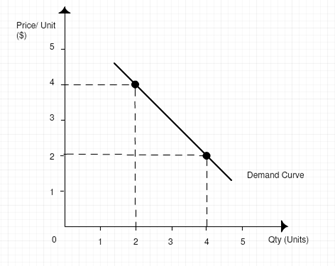
The consumer equilibrium in three commodity case and also draw the demand curve for good A.
Concept Introduction:
The
Consumer equilibrium: In order to maximize his utility, the consumer will spend his income in such a way so that the following condition is satisfied:
Explanation of Solution
(a) With the help of given information, we can find out the consumers equilibrium in three commodity case. The following condition has to be satisfied in order to maximize the utility.
The price of A = $2
The price of B = $3
The price of C = $1
| Quantity | | | | | | |
| 1 | 50 | 75 | 25 | 25 | 25 | 25 |
| 2 | 40 | 60 | 20 | 20 | 20 | 20 |
| 3 | 30 | 40 | 15 | 15 | 13.33 | 15 |
| 4 | 20 | 30 | 10 | 10 | 10 | 10 |
| 5 | 15 | 20 | 7.5 | 7.5 | 6.66 | 7.5 |
Daniel’s income is $24 per week.
The utility can be maximized when Daniel consumes 4 units of each good A, B and C because at this level, consumer’s equilibrium condition is satisfied and he is spending his whole income on purchase of these goods.
(b) If the price of A is $4 and other things are held constant.
| Quantity | | | | | | |
| 1 | 50 | 75 | 25 | 12.5 | 25 | 25 |
| 2 | 40 | 60 | 20 | 10 | 20 | 20 |
| 3 | 30 | 40 | 15 | 7.5 | 13.33 | 15 |
| 4 | 20 | 30 | 10 | 5 | 10 | 10 |
| 5 | 15 | 20 | 7.5 | 3.75 | 6.66 | 7.5 |
In this case, consumer will purchase 2 units of good A and 4 units of good B and C. In this way, he will be able to spend his entire income on the purchase of three goods and maximizes his utility.
(c) When the price of good A is $2, Daniel is consuming 4 units of good A.
When the price of good A rises to $4, Daniel is consuming 2 units of good A. We can plot these points on the graph and will get the demand curve.

Want to see more full solutions like this?
Chapter 6 Solutions
ECON MICRO (with ECON MICRO Online, 1 term (6 months) Printed Access Card) (New, Engaging Titles from 4LTR Press)
- Use the Feynman technique throughout. Assume that you’re explaining the answer to someone who doesn’t know the topic at all. Write explanation in paragraphs and if you use currency use USD currency: 10. What is the mechanism or process that allows the expenditure multiplier to “work” in theKeynesian Cross Model? Explain and show both mathematically and graphically. What isthe underpinning assumption for the process to transpire?arrow_forwardUse the Feynman technique throughout. Assume that you’reexplaining the answer to someone who doesn’t know the topic at all. Write it all in paragraphs: 2. Give an overview of the equation of exchange (EoE) as used by Classical Theory. Now,carefully explain each variable in the EoE. What is meant by the “quantity theory of money”and how is it different from or the same as the equation of exchange?arrow_forwardZbsbwhjw8272:shbwhahwh Zbsbwhjw8272:shbwhahwh Zbsbwhjw8272:shbwhahwhZbsbwhjw8272:shbwhahwhZbsbwhjw8272:shbwhahwharrow_forward
- Use the Feynman technique throughout. Assume that you’re explaining the answer to someone who doesn’t know the topic at all:arrow_forwardUse the Feynman technique throughout. Assume that you’reexplaining the answer to someone who doesn’t know the topic at all: 4. Draw a Keynesian AD curve in P – Y space and list the shift factors that will shift theKeynesian AD curve upward and to the right. Draw a separate Classical AD curve in P – Yspace and list the shift factors that will shift the Classical AD curve upward and to the right.arrow_forwardUse the Feynman technique throughout. Assume that you’re explaining the answer to someone who doesn’t know the topic at all: 10. What is the mechanism or process that allows the expenditure multiplier to “work” in theKeynesian Cross Model? Explain and show both mathematically and graphically. What isthe underpinning assumption for the process to transpire?arrow_forward
- Use the Feynman technique throughout. Assume that you’re explaining the answer to someone who doesn’t know the topic at all: 15. How is the Keynesian expenditure multiplier implicit in the Keynesian version of the AD/ASmodel? Explain and show mathematically. (note: this is a tough one)arrow_forwardUse the Feynman technique throughout. Assume that you’re explaining the answer to someone who doesn’t know the topic at all: 13. What would happen to the net exports function in Europe and the US respectively if thedemand for dollars rises worldwide? Explain why.arrow_forward20. Given the mathematical model below, solve for the expenditure multiplier for a) government spending, G; and b) for consumer taxes, T. (medium difficulty) Y=C+I+G C=Co+b(Y-T) 1 = 10 T=To+tY G = Go+gYarrow_forward
- Use the Feynman technique throughout. Assume that you’re explaining the answer to someone who doesn’t know the topic at all: 11. What exactly is a rectangular hyperbola and what relevance is it to classical economics?arrow_forwardUse the Feynman technique throughout. Assume that you’re explaining the answer to someone who doesn’t know the topic at all: 9. Explain the difference between absolute and comparative advantage in a family setting, i.e.using parents and children. What can we glean from knowing about comparative andabsolute advantages?arrow_forwardUse the Feynman technique throughout. Assume that you’re explaining the answer to someone who doesn’t know the topic at all: 18. Explain why most economists believe it is absolutely necessary to allow free trade in aneconomy. Why is it harmful (under most circumstances) to have tariffs and trade barriers?arrow_forward
 Principles of Economics (MindTap Course List)EconomicsISBN:9781305585126Author:N. Gregory MankiwPublisher:Cengage Learning
Principles of Economics (MindTap Course List)EconomicsISBN:9781305585126Author:N. Gregory MankiwPublisher:Cengage Learning Principles of Economics, 7th Edition (MindTap Cou...EconomicsISBN:9781285165875Author:N. Gregory MankiwPublisher:Cengage Learning
Principles of Economics, 7th Edition (MindTap Cou...EconomicsISBN:9781285165875Author:N. Gregory MankiwPublisher:Cengage Learning

 Economics (MindTap Course List)EconomicsISBN:9781337617383Author:Roger A. ArnoldPublisher:Cengage Learning
Economics (MindTap Course List)EconomicsISBN:9781337617383Author:Roger A. ArnoldPublisher:Cengage Learning





